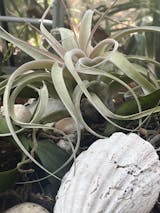Check out this collection from Cargo Report - Vol. 10 #3, December 2000
Tillandsia xerographica
350
THIS PLANT IS ON C.I.T.E.S. AND CANNOT BE EXPORTED
A beautiful and collectible Tillandsia from Guatemala which forms a large open rosette with wide recurving silver leaves and a handsome yellow inflorescence. Grown mounted or in a basket, the leaves will hang in long curls. Native to seasonally dry forests where they receive abundant sun and good air circulation, in cultivation does well in a hanging basket or a string ‘cradle’, just suspended in a bright, airy place.
A magnificent species now listed as endangered by C.I.T.E.S.










plant is much larger than expected - very good condition
This is a spectacular specimen in perfect condition! I love it and would love to get more in the future.
If you’re in Sarasota, check out the display of these plants being installed at Selby Gardens as part of the upcoming Kasuma exhibit (see photo), then go to Tropiflora to buy your own!
I have purchased plants from Tropiflora both in person and by mail . I recently received a Xerographica which arrived promptly and in great shape. Indeed, all of my purchases have been great and timely.
Excellent service, professional handling and shipping. Amazing, healthy beautiful. Thank You.
I was so excited about the way it was mounted. All I had to do was just go home and hang it up sometime the hardest part is trying to decide how to display them. This was quick easy and I enjoy looking at it every day. Hands down, you have the best selection, healthiest plants, and great prices.
You always feel like family when you shop at tropiflora
Tillandsia subteres
494
This beautiful species is native to only a couple of isolated canyons in central Honduras. A large upright grower to over 30 inches, with stiff, reddish leaves and an inflorescence of long pink, upright, terete branches.
In nature it lives at the base of cliffs, supporting itself against rocks and other plants. In cultivation it can be kept bare root, mounted or may be potted in a well drained media.







